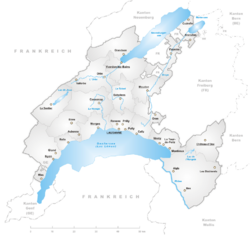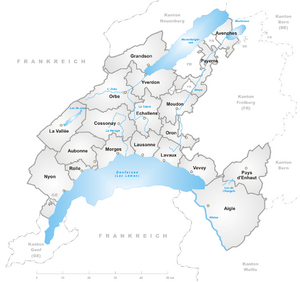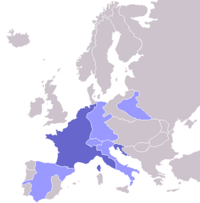Vaud
| Vaud | |||
|
|||
| Capital | Lausanne | ||
| Population (2007) | 672,039 (Ranked 3rd) | ||
| - Density | 205 /km² | ||
| Area | 3212 km² (Ranked 4th) | ||
| Highest point | 3210 m - Les Diablerets | ||
| Lowest point | 372 m - Lake Geneva | ||
| Joined | 1803 | ||
| Abbreviation | VD | ||
| Languages | French | ||
| Executive | Conseil d'Etat (7) | ||
| Legislative | Grand Conseil (150) | ||
| Municipalities | 376 (as of 2008-01-01) municipalities | ||
| Districts | 10 districts | ||
| Website | www.VD.ch | ||
 |
|||
The Canton of Vaud (French pronunciation [vo]) is one of the 26 cantons of Switzerland and is located in Romandy, the southwestern part of the country. The capital is Lausanne.
Contents |
Geography

The canton stretches from Lake Neuchâtel in the north, where it borders the canton of Neuchâtel to Lake Geneva in the south, bordering the canton of Geneva, Haute-Savoie (lake border with France) and canton of Valais. On the Jura ranges in the west, the canton borders the French départements of Ain, Jura, and Doubs. In the east, it borders canton of Fribourg and canton of Bern. The total area is 3,212 square kilometers (1,240.2 sq mi).
In the north, there is an exclave containing Avenches surrounded by canton of Fribourg and Lake Neuchâtel. On the other hand, there are two enclaves of the canton of Fribourg, as well as two enclaves of the canton of Geneva, that are surrounded by the canton of Vaud.
The areas in the southeast are mountainous, situated in the Alps (Bernese Alps). The Diablerets massif, peaking at 3,210 meters (10,531 ft), is the highest mountain of the canton, which also host several popular skiing destinations such as Villars, Les Diablerets and Leysin. The central area of the canton, in contrast, consists of moraines and is thus hilly. There are plains along the lakes.
History
Along the lakes, Vaud was inhabited in prehistoric times. Later on, the Celtic tribe of the Helvetii inhabited the area. The tribe was defeated by Caesar's troops in 58 BC and as a consequence the Romans settled the area. The towns of Vevey (Latin: Viviscus) and Lausanne (Lausonium or Lausonna) are two of the many towns established by the Romans.
In 27 BC the state of Civitas Helvetiorum was established around the capital of Avenches (Aventicum). There are still many Roman remains around the town today. Between the 2nd and the 4th century the area was repeatedly invaded by Alemannic tribes, and in the 5th century the Burgundians occupied the area. The Merovingian Franks later replaced the Burgundians. Their occupancy did not last long either, and in 888 the area of the canton of Vaud was made part of the Carolingian Empire. In 1032 the Zähringens of Germany defeated the Burgundians. The Zähringens themselves were succeeded in 1218 by the counts of Savoy. It was only under the counts of Savoy that the area was given political unity, establishing what is today in greater part known as the canton of Vaud. A part stretching from Attalens to the River Sarine, in the north, was absorbed by the canton of Fribourg.
As the power of the Savoys declined at the beginning of the 15th century the land was occupied by troops from Bern. By 1536 the area was completely annexed. Reformation was started by co-workers of John Calvin like Pierre Viret, including a famous debate at the cathedral of Lausanne; but it was only decisively implemented when Bern put its full force behind it. The Bernese occupants were not popular amongst the population and the French Revolutionary troops were received with enthusiasm in 1798. The French troops were victorious and a Lemanic Republic was declared. This was soon turned into the canton of Léman, which in 1803 joined the Swiss confederation.
The current constitution dates from April 14 2003, replacing the one from 1885. In the 19th century the canton of Vaud was an outspoken opponent of the Catholic separatist movement (Sonderbund).
Ian Fleming, when writing the fictional biography of James Bond, mentioned that Bond's mother was "Monique Delacroix, a Swiss woman from the Canton de Vaud".
Culture
Vaud shares a lot with its fellow French-speaking Protestant cantons of Geneva and Neuchâtel. It has still a strong rural component, protected by high subsidies, even if most of the economy and population are now urbanised, around services (finance, telecommunications, tourism) and industry (packaging, tobacco, food-processing, watchmaking, pharmaceuticals &c). There are survivals of its own Franco-Provençal patois, around which an association was formed.
Quality of life is very high, but the birthrate is very low. Life expectancy is high. Education shares the generally high Swiss standards.
Economy
The capital Lausanne is the major city in the canton. There are light industries concentrated around it. In 1998, 71.7% of the workers worked in the tertiary sector and 20.8% in the secondary.
The canton is the second largest producer of wine in Switzerland. Most of the wine produced in the canton is white wine, and most vineyards are located on the steep shores of Lake Geneva. There is agriculture in the areas away from Lake Geneva. Sugar beet is important around Orbe, tobacco in La Broye Valley and fruit is grown on the foot of the Jura mountains. Cattle breeding and pasture are common in the Alps and the Jura mountains. There is a salt mine at Bex. Tourism is important in many towns along the Lake Geneva. Major lakeside resorts include Lausanne, Montreux and Vevey.
Education
The Canton is home to several renowned universities and schools:
- Swiss Federal institute of Technology, Lausanne (EPFL)
- University of Lausanne (UNIL)
- International Institute for Management Development (IMD)
- École Cantonale d'Art de Lausanne, Lausanne Art School (ECAL)
- Institut Le Rosey
- Glion Institute of Higher Education, Glion Institute of higher Education
- The American Graduate School of Business
- Business School Lausanne (BSL)
- Château de Bossey
Districts

Since January 1, 2008, Vaud was reorganized into 10 districts:
- Aigle, capital Aigle
- Broye-Vully (which combined the districts of Avenches and Payerne, and part of the districts of Moudon and Oron), capital Payerne
- Gros-de-Vaud (which combined the district of Echallens, and part of the districts of Cossonay, Moudon, and Oron), capital Echallens
- Jura-North Vaudois (which combined the districts of Grandson, Orbe, and Yverdon), capital Yverdon-les-Bains
- Lausanne (part of the previous district was merged into West Lausannois), capital Lausanne
- Lavaux-Oron (which combined the district of Lavaux and part of the district of Oron), capital Cully
- Morges (which combined parts of the districts of Aubonne, Cossonay, Morges, and Rolle), capital Morges
- Nyon (part of Rolle district merged into Nyon), capital Nyon
- Riviera-Pays-d'Enhaut (which combined the districts of Pays-d'Enhaut and Vevey), capital Vevey
- West Lausannois (which was carved out of parts of the districts of Lausanne and Morges), capital Renens

From 1803 till 2007 the Canton of Vaud has been divided into 19 districts:
- Aigle, capital Aigle
- Aubonne, capital Aubonne
- Avenches, capital Avenches
- Cossonay, capital Cossonay
- Echallens, capital Echallens
- Grandson, capital Grandson
- Lausanne, capital Lausanne
- Lavaux, capital Cully
- Morges, capital Morges
- Moudon, capital Moudon
- Nyon, capital Nyon
- Orbe, capital Orbe
- Oron, capital Oron
- Payerne, capital Payerne
- Pays-d'Enhaut, capital Château-d'Œx
- Rolle, capital Rolle
- La Vallée, capital Le Sentier (in Le Chenit)
- Vevey, capital Vevey
- Yverdon, capital Yverdon-les-Bains
Demographics
The population is French-speaking and has been overwhelmingly Protestant (Calvinist) since the early years of the Reformation.
The population of the canton is 672,039 (2007) of which 195,071 (or 29%) are foreigners[1]. The major population centers of the canton are: Lausanne (approx. 275,000 inhabitants in 2000), Montreux-Vevey (70,000 inhabitants) and Yverdon-les-Bains. The region around Nyon is often considered part of the agglomeration of Geneva. All of these are on Lake Geneva, except for Yverdon, which is on Lake Neuchâtel.
Other cities and towns include: Morges, Renens, Rolle.
See also
- Municipalities of the canton of Vaud
- Lausanne - Capital of the canton.
- French language
- Franco-Provençal language
External links
- Cantonal government (French)
- Vaud Tourist Office
- Official Statistics
- Maps and Charts of Canton of Vaud
- List of Swiss municipalities
References
- ↑ Bundesamt fur Statistik (Federal Department of Statistics) (2008). "Ständige Wohnbevölkerung nach Staatsangehörigkeit, Geschlecht und Kantonen" (Microsoft Excel). Retrieved on November 5, 2008.
|
||||||||||||||||||||||||||||||||||||||||||||


